2024年高考二轮复习英语专题突破题型六: 读后续写 第三节 开头结尾巧构思 课件 (共39张PPT)
文档属性
| 名称 | 2024年高考二轮复习英语专题突破题型六: 读后续写 第三节 开头结尾巧构思 课件 (共39张PPT) |  | |
| 格式 | pptx | ||
| 文件大小 | 537.2KB | ||
| 资源类型 | 教案 | ||
| 版本资源 | 通用版 | ||
| 科目 | 英语 | ||
| 更新时间 | 2024-04-17 22:27:38 | ||
图片预览



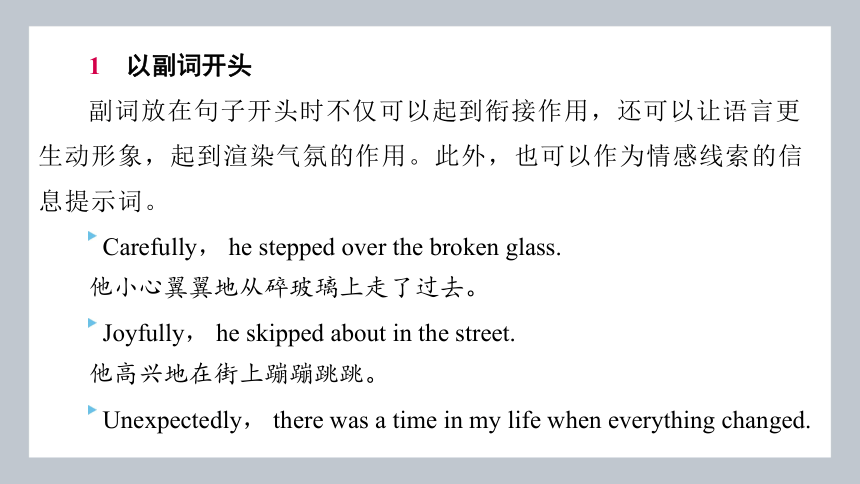
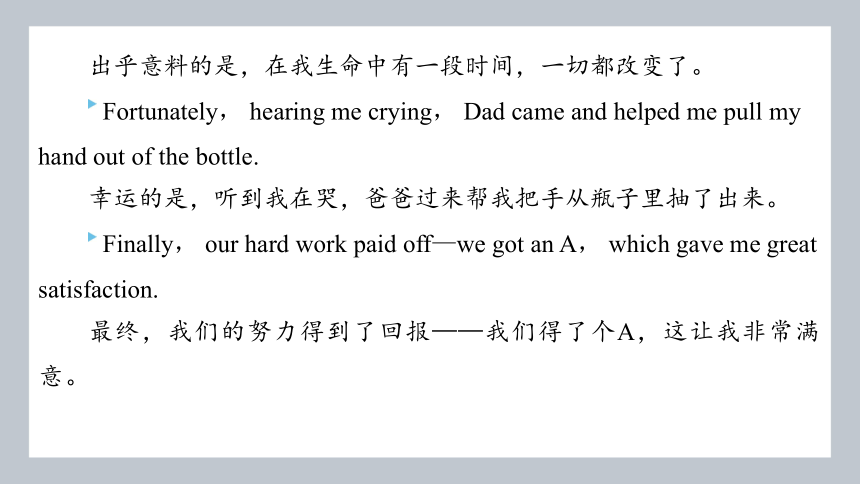


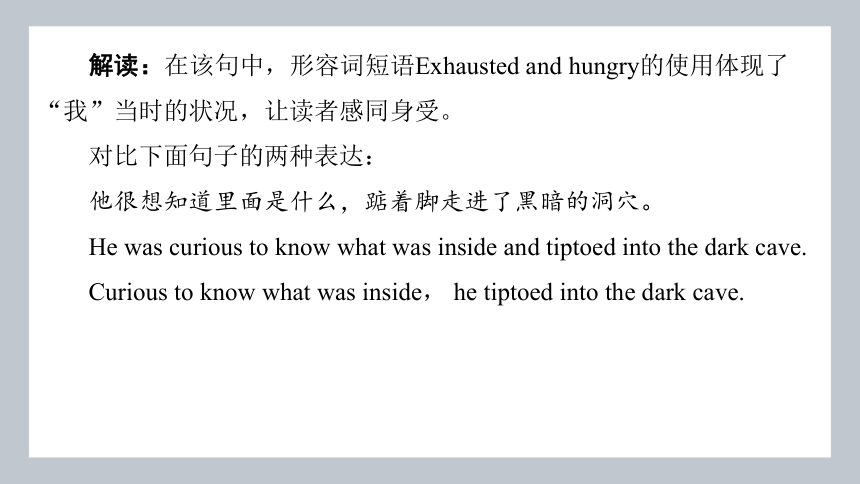

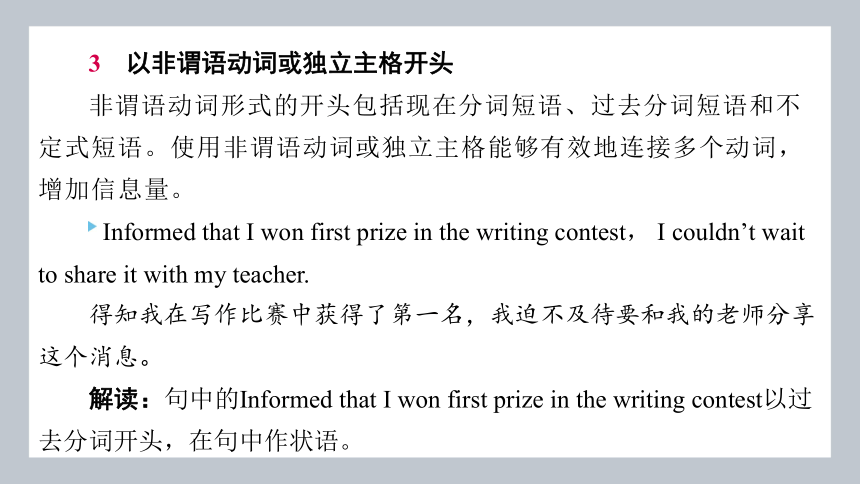
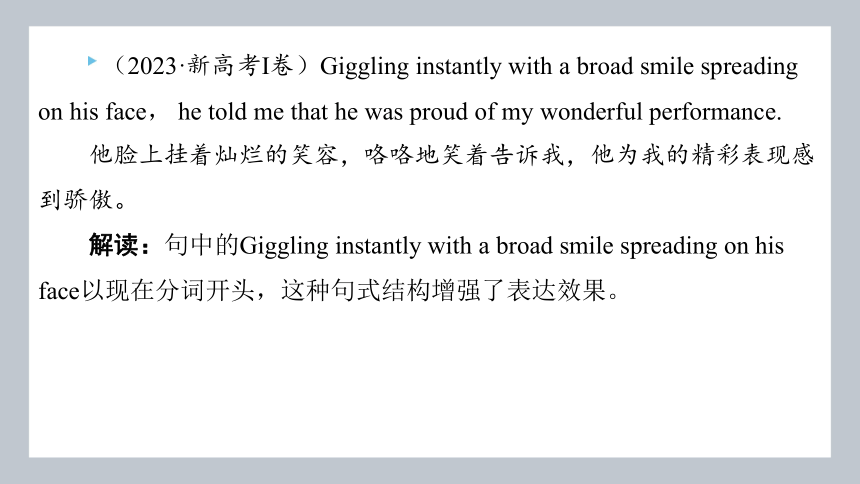

文档简介
(共39张PPT)
题型六 读后续写
第三节 开头结尾巧构思
一、 引人入胜的开头
写好故事的开头非常重要,它可以引起读者的兴趣,从而吸引读者
继续阅读。那么如何写出引人入胜的开头呢?可以借鉴以下几种方法:
1 以副词开头
副词放在句子开头时不仅可以起到衔接作用,还可以让语言更
生动形象,起到渲染气氛的作用。此外,也可以作为情感线索的信
息提示词。
Carefully, he stepped over the broken glass.
他小心翼翼地从碎玻璃上走了过去。
Joyfully, he skipped about in the street.
他高兴地在街上蹦蹦跳跳。
Unexpectedly, there was a time in my life when everything changed.
出乎意料的是,在我生命中有一段时间,一切都改变了。
Fortunately, hearing me crying, Dad came and helped me pull my
hand out of the bottle.
幸运的是,听到我在哭,爸爸过来帮我把手从瓶子里抽了出来。
Finally, our hard work paid off—we got an A, which gave me great
satisfaction.
最终,我们的努力得到了回报——我们得了个A,这让我非常满
意。
解读:(1) 前两句中Carefully和Joyfully两个副词分别将后面的两
个动作stepped和skipped描写得更加生动形象。
(2) 第三句中使用Unexpectedly这一副词开头,表示情况发生了
转折,能够引起读者的注意。
(3) 第四、五句中把Fortunately和Finally放在句首也是写作中比较
经典的用法,能够引起读者的情感共鸣,让人产生如释重负的感觉。
2 以形容词短语开头
如果中规中矩地使用形容词短语,会使其失去色彩,但如果将形容
词短语直接放在句首或句尾,并用逗号将其与句子的主体隔开,就能够
烘托出主人公的心理活动及变化,并且对主语做出补充。
We had no idea where we were and it got dark. Exhausted and
hungry, I wondered if we could find our way back。
我们不知道自己在哪里,天(也)黑了。我筋疲力尽、饥肠辘辘,
想知道我们是否能找到回去的路。
解读:在该句中,形容词短语Exhausted and hungry的使用体现了
“我”当时的状况,让读者感同身受。
对比下面句子的两种表达:
他很想知道里面是什么,踮着脚走进了黑暗的洞穴。
He was curious to know what was inside and tiptoed into the dark cave.
Curious to know what was inside, he tiptoed into the dark cave.
解读:在第一个句子中, curious用作表语,句子平淡无奇,但是在
第二个句子中,形容词短语放在了句首,表明他进洞穴的原因,这样的
表达不但能够和上文内容进行有效衔接,而且能让人感受到他内心的好
奇,调动起读者的情绪。
3 以非谓语动词或独立主格开头
非谓语动词形式的开头包括现在分词短语、过去分词短语和不
定式短语。使用非谓语动词或独立主格能够有效地连接多个动词,
增加信息量。
Informed that I won first prize in the writing contest, I couldn’t wait
to share it with my teacher.
得知我在写作比赛中获得了第一名,我迫不及待要和我的老师分享
这个消息。
解读:句中的Informed that I won first prize in the writing contest以过
去分词开头,在句中作状语。
(2023·新高考Ⅰ卷)Giggling instantly with a broad smile spreading
on his face, he told me that he was proud of my wonderful performance.
他脸上挂着灿烂的笑容,咯咯地笑着告诉我,他为我的精彩表现感
到骄傲。
解读:句中的Giggling instantly with a broad smile spreading on his
face以现在分词开头,这种句式结构增强了表达效果。
4 以对话或独白开头
“未见其人,先闻其声。”这种“先声夺人”的写作手法可以使人
物一出场就吸引人们的注意。对话描写还可以反映人物的心理与情感,
刻画人物的性格。但是以对话开头要注意以下几个方面:
(1) 对话描写必须为推动故事情节服务,是情节发展的一个环
节,不宜过多或过长。
(2) 对话要符合人物的性格和年龄特征,而且侧重口语化词汇,
避开生僻词汇。
(3) 对话描写要尽可能结合动作描写,明确说话对象,增强画面
感,如果能够使用几个感叹词,表达说话人的喜、怒、哀、乐等情绪则
更佳。
“Let’s see who gets there first!” Rachel shouted, as she pedaled
fast and zoomed past Jenny.
“让我们看看谁先到那里!”雷切尔一边叫着,一边飞快地骑着自
行车从詹妮身边疾驰而过。
(2022·新高考Ⅰ卷)“I was afraid that kids from other schools would
laugh at him,” he explained uncomfortably. “I gave him the choice to run
or not, and let him decide.”
“我担心其他学校的孩子会嘲笑他。”他不安地解释道,“我给他
是否参加赛跑的选择,让他自己决定。”
体会以下两种句子不同的顺序:
(2022·新高考Ⅰ卷)我轻言细语地说:“除了你自己,没有人能改
变你的主意。”
I said gently and quietly, “No one can change your mind, except
yourself.”(平淡无奇)
“No one can change your mind, except yourself,” I said gently
and quietly.(先声夺人)
5 以背景描写开头
背景场景是由人、事、环境、气氛等组合起来的综合画面。借景抒
情、寓情于景是写作中常用的手法。恰当的背景描写有利于推动故事情
节的发展,烘托人物的心理活动,给读者身临其境的感受。可以描写事
件发生的时间、地点、环境等,也可以描写人看到的景象或感受到的某
种情绪。
I looked out of the car window, and the beautiful scenery entirely
attracted my attention.
→ I looked out of the car window, winding rivers, lofty mountains,
sunny beaches and deep valleys holding a fascination for me.(使用了“视
觉+环境描写”的写作手法,成功地吸引了读者的注意力。)
我朝车窗外望去,蜿蜒的河流、高耸的群山、阳光明媚的海滩和深
邃的山谷让我着迷。
There was almost no wind, only the flames of the fire in the company
of us.(通过描写无风、火焰相伴的场景表现了环境的安静,营造出温馨
和谐的画面,烘托出人物的闲适心情。)
几乎没有风,只有篝火的火焰和我们相伴。
As the night fell, dark clouds gathering overhead and the sky
suddenly going dark, it began to blow harder and harder.(通过描写夜幕
降临、乌云密布、狂风四起的场景,渲染了阴森恐怖的气氛,反映出人
物极为紧张的心情。)
随着夜幕降临,空中乌云密布,天空骤然转暗,风开始越刮越大。
A gentle breeze came up, wrinkling the surface of the lake.
微风吹起,湖面起了褶皱。
The spring morning is quiet. Only birds sing cheerfully and restlessly.
春日的早晨很安静。只有鸟儿在欢快地不停地歌唱。
A little way off was a small stream, rushing and sparkling along
between green banks.
不远处有一条小溪,在绿色的两岸之间奔流不息,波光粼粼。
The lakes shone like mirrors in the setting sun and looked wonderful.
湖泊在落日下闪亮如镜,景色迷人。
In the distance, we could see mist rising from the lake, which
remains fresh in my memory.
在远处,我们可以看到薄雾从湖上升起,那个情景我记忆犹新。
注意:这些寓情于景、动静结合的描写放在开头只是起到画龙点睛
的作用,不需要太长。
二、 韵味十足的结尾
精彩的结尾好似画龙点睛,不仅能够唤起读者的思考与共鸣,还能
够增强文章的感染力,让人回味无穷。在表现手法上,结尾还应与前文
的伏笔照应,使人觉得在情理之中;与前文形成呼应,点明主旨,深化
主题。
1 首尾呼应法
首尾呼应法也称回环照应式。结尾与开头照应,有时可引用作者在
开头的观点。结尾回到文章开头阐明的中心思想或主题句上,深化主
题,起到画龙点睛的效果。但要注意一点,不要照搬开头的句子,要变
化句式或者用词来表达相同的主题。通过首尾呼应,利用文章伏笔完成
主旨的升华。
此处以2021年新高考Ⅰ/Ⅱ卷为例:
主要内容:文章讲述的是一对双胞胎在母亲节为妈妈做早餐,送
上节日惊喜的故事。
原文开头: The twins were filled with excitement as they thought of
the surprise they were planning for Mother’s Day.想到为母亲节准备的惊
喜,这对双胞胎充满了兴奋。
续写结尾的时候可以呼应原文开头,进一步凸显母亲节这天这对双
胞胎给母亲带来的惊喜与兴奋。
续文结尾: Father was standing in the doorway, recording this
touching scene. The whole room was bathed in a happy Mother’s Day
atmosphere.
父亲站在门口,录下了这感人的场景。整个房间都沐浴在母亲节快
乐的气氛中。
结尾处回扣原文开头,这种处理使得首尾呼应,内容完整,结构紧
凑,保留了文章前后一致的逻辑。
主要内容:文章讲述的是作者一家四口驾车外出旅行时,由于妈
妈的健忘,发生的一些趣事。
原文开头: I had an interesting childhood. It was filled with surprises
and joys, all because of my mother—loving, kind, yet absent-minded
and forgetful.
我有一个有趣的童年。它充满了惊喜和乐趣,这都是因为我的母
亲。她满怀爱意、善良,却心不在焉、健忘。
续写结尾的时候可以照应原文开头,再次表明母亲的性格,来深化
主题。
续文结尾: Despite Mom’s being absent-minded and forgetful, she
was still a kind and nice mom.尽管妈妈心不在焉、健忘,她仍然是一个和
蔼可亲的妈妈。
2 哲理式结尾
哲理式结尾也称道理寓意式结尾,即在结尾使用富含哲理的语句,
总结全文,升华主旨,并给人以启迪。合理使用名言可以使续写文章锦
上添花,起到“言已尽而意无穷”的效果,使文章的中心更突出。我们
平常可以积累一些富含哲理的段落或句子。
Don’t judge each day by the harvest you reap but by the seeds that you
plant.
不要以你的收成来评价每一天,而要看你每天播种了多少。
解读:这句话将人的付出和回报比作播种和收成,强调过程比
结果重要,可以用于习惯养成类或者长期活动类叙事的结尾,以提
升思想境界。
Life is not about how to survive the storm, but how to dance in the
rain.
生活不在于如何在暴风雨中幸存下来,而在于如何在雨中跳舞。
It is love that makes the world go round. Just as a saying goes, “The
fragrance always stays in the hand that gives the rose.”
是爱使世界转动。正如谚语所说:“赠人玫瑰,手有余香。”
It dawned on me that a moment of kindness could mean so much to
another, and that a simple act could make the world better.
我开始明白,一刻的善意对另一个人来说可能意义重大,一个简单
的举动可以让世界变得更美好。
此处以2022年浙江卷为例:
Paragraph 2:
One day I got word that he was admitted to hospital for a serious
disease. I thought I should visit him in any case. He was a little surprised to
see me when I stepped into his ward. I offered to do the rest of our project
work and he invited me to share my ideas to perfect it. Our hard work paid
off and Dr Henderson was satisfied with our wonderful performance. From
this project, we learned the significance of teamwork. Just as the saying
goes, “One person can go fast, but a group of persons can go far.”
此段续写的原文讲述了亨德森博士在心理学课上给作者指定项目伙
伴的故事。作者和他在班上想要避开的一位同学分到了一个组。这个同
学冷漠、高傲,对作者不理不睬。作者在与他讨论项目时感觉很不自
在,但还是坚持了下来,最终圆满地完成了课题研究。续写结尾采用谚
语“一个人可以走得很快,但一群人可以走得很远。”点明本文的主
题——合作的重要性。这使得续写结尾更有说服力,同时能提升人们的
思想境界。
哲理式结尾佳句积累:
Be thankful for what you have, and you’ll end up having more. If you
concentrate on what you don’t have, you’ll never ever have enough. 感激你
所拥有的,最终你会得到更多。如果你专注于自己没有的东西,那么你
永远也不会满足。
The best way to defeat your fear is to face your fear head-on.
战胜恐惧最好的方法是直面恐惧。
Never underestimate yourself, for you have no idea what you are
capable of.
永远不要低估你自己,因为你不知道自己的能力。
Just as the famous saying goes, “Sunshine always comes after the
storm.” We will meet various challenges in life, but we should never give
up easily.
正如名言所说:“阳光总在风雨后。”人生中我们会碰到各种挑
战,但我们绝不该轻易放弃。
3 情感升华法
每一个故事的创作不仅仅是为了讲清楚一件事情的来龙去脉,还要
包含作者想要表达的寓意、想与读者分享的感悟。在续写时,我们可以
通过表明人生感悟、生活真谛、生活哲理、人生观或价值观来达到结尾
部分的情感升华。
主要内容:文章讲述的是作者一家四口驾车外出旅行时,由于妈
妈的健忘,发生的一些趣事。
原文开头: I had an interesting childhood. It was filled with surprises
and joys, all because of my mother—loving, kind, yet absent-minded
and forgetful.
我有一个有趣的童年。它充满了惊喜和乐趣,这都是因为我的母
亲。她满怀爱意、善良,却心不在焉、健忘。
续文结尾: Everyone has one person they look up to as a role model.
To me, there is none other than my mom. Without her, I would have no
idea whether I can be a famous dancer. Someday, when I am older and have
children of my own, I hope I can be just as great a parent as my mom.
每个人都有一个自己钦佩的人作为榜样。对我来说,(这个人)正
是我的妈妈。如果没有她,我不知道我能不能成为一个著名的舞者。有
一天,当我年龄再大点,有了自己的孩子,我希望我能成为像我妈妈一
样伟大的母亲。
4 使用高级句式升华主旨
在进行读后续写时,恰当选择一些高级、地道的句式,往往给人耳
目一新的感觉,有时起到画龙点睛的作用。在续写时,可以考虑使用以
下句式结构。
(1) 使用情感升华句式“Seeing sth., I felt as if it had been doing
and saying, ‘ ...’”来升华主旨。
Seeing the alphabet again, I felt as if it had been encouraging me and
saying, “It’s never too late to learn.”
再次看到字母表,我觉得它好像在鼓励我并说:“活到老学到
老。”
(2) 使用“From then on +行动+ Only in this way could/can
sb. ...”句式来升华主旨。
From then on, Bernard made up his mind to help someone who
needed help. Only in this way could more and more people help each other.
从那时起,伯纳德下定决心帮助需要帮助的人。只有这样,才会有
越来越多的人互相帮助。
(3) 使用特殊句式,如虚拟语气、倒装句和强调句等来升华
主旨。
Only then did I realize that it was bravery that could conquer whatever
difficulty came in the way.
直到那时,我才意识到,正是勇气才能克服(前进)路上的一
切困难。
It was this unique experience that made me understand that whatever
difficulty we are faced with, we shouldn’t give up our hope.
正是这种独特的经历使我认识到无论我们面临什么困难,我们都不
应该放弃我们的希望。
Given one more chance, I wouldn’t have judged a person by his
appearance.
再给我一次机会,我就不会以貌取人了。
题型六 读后续写
第三节 开头结尾巧构思
一、 引人入胜的开头
写好故事的开头非常重要,它可以引起读者的兴趣,从而吸引读者
继续阅读。那么如何写出引人入胜的开头呢?可以借鉴以下几种方法:
1 以副词开头
副词放在句子开头时不仅可以起到衔接作用,还可以让语言更
生动形象,起到渲染气氛的作用。此外,也可以作为情感线索的信
息提示词。
Carefully, he stepped over the broken glass.
他小心翼翼地从碎玻璃上走了过去。
Joyfully, he skipped about in the street.
他高兴地在街上蹦蹦跳跳。
Unexpectedly, there was a time in my life when everything changed.
出乎意料的是,在我生命中有一段时间,一切都改变了。
Fortunately, hearing me crying, Dad came and helped me pull my
hand out of the bottle.
幸运的是,听到我在哭,爸爸过来帮我把手从瓶子里抽了出来。
Finally, our hard work paid off—we got an A, which gave me great
satisfaction.
最终,我们的努力得到了回报——我们得了个A,这让我非常满
意。
解读:(1) 前两句中Carefully和Joyfully两个副词分别将后面的两
个动作stepped和skipped描写得更加生动形象。
(2) 第三句中使用Unexpectedly这一副词开头,表示情况发生了
转折,能够引起读者的注意。
(3) 第四、五句中把Fortunately和Finally放在句首也是写作中比较
经典的用法,能够引起读者的情感共鸣,让人产生如释重负的感觉。
2 以形容词短语开头
如果中规中矩地使用形容词短语,会使其失去色彩,但如果将形容
词短语直接放在句首或句尾,并用逗号将其与句子的主体隔开,就能够
烘托出主人公的心理活动及变化,并且对主语做出补充。
We had no idea where we were and it got dark. Exhausted and
hungry, I wondered if we could find our way back。
我们不知道自己在哪里,天(也)黑了。我筋疲力尽、饥肠辘辘,
想知道我们是否能找到回去的路。
解读:在该句中,形容词短语Exhausted and hungry的使用体现了
“我”当时的状况,让读者感同身受。
对比下面句子的两种表达:
他很想知道里面是什么,踮着脚走进了黑暗的洞穴。
He was curious to know what was inside and tiptoed into the dark cave.
Curious to know what was inside, he tiptoed into the dark cave.
解读:在第一个句子中, curious用作表语,句子平淡无奇,但是在
第二个句子中,形容词短语放在了句首,表明他进洞穴的原因,这样的
表达不但能够和上文内容进行有效衔接,而且能让人感受到他内心的好
奇,调动起读者的情绪。
3 以非谓语动词或独立主格开头
非谓语动词形式的开头包括现在分词短语、过去分词短语和不
定式短语。使用非谓语动词或独立主格能够有效地连接多个动词,
增加信息量。
Informed that I won first prize in the writing contest, I couldn’t wait
to share it with my teacher.
得知我在写作比赛中获得了第一名,我迫不及待要和我的老师分享
这个消息。
解读:句中的Informed that I won first prize in the writing contest以过
去分词开头,在句中作状语。
(2023·新高考Ⅰ卷)Giggling instantly with a broad smile spreading
on his face, he told me that he was proud of my wonderful performance.
他脸上挂着灿烂的笑容,咯咯地笑着告诉我,他为我的精彩表现感
到骄傲。
解读:句中的Giggling instantly with a broad smile spreading on his
face以现在分词开头,这种句式结构增强了表达效果。
4 以对话或独白开头
“未见其人,先闻其声。”这种“先声夺人”的写作手法可以使人
物一出场就吸引人们的注意。对话描写还可以反映人物的心理与情感,
刻画人物的性格。但是以对话开头要注意以下几个方面:
(1) 对话描写必须为推动故事情节服务,是情节发展的一个环
节,不宜过多或过长。
(2) 对话要符合人物的性格和年龄特征,而且侧重口语化词汇,
避开生僻词汇。
(3) 对话描写要尽可能结合动作描写,明确说话对象,增强画面
感,如果能够使用几个感叹词,表达说话人的喜、怒、哀、乐等情绪则
更佳。
“Let’s see who gets there first!” Rachel shouted, as she pedaled
fast and zoomed past Jenny.
“让我们看看谁先到那里!”雷切尔一边叫着,一边飞快地骑着自
行车从詹妮身边疾驰而过。
(2022·新高考Ⅰ卷)“I was afraid that kids from other schools would
laugh at him,” he explained uncomfortably. “I gave him the choice to run
or not, and let him decide.”
“我担心其他学校的孩子会嘲笑他。”他不安地解释道,“我给他
是否参加赛跑的选择,让他自己决定。”
体会以下两种句子不同的顺序:
(2022·新高考Ⅰ卷)我轻言细语地说:“除了你自己,没有人能改
变你的主意。”
I said gently and quietly, “No one can change your mind, except
yourself.”(平淡无奇)
“No one can change your mind, except yourself,” I said gently
and quietly.(先声夺人)
5 以背景描写开头
背景场景是由人、事、环境、气氛等组合起来的综合画面。借景抒
情、寓情于景是写作中常用的手法。恰当的背景描写有利于推动故事情
节的发展,烘托人物的心理活动,给读者身临其境的感受。可以描写事
件发生的时间、地点、环境等,也可以描写人看到的景象或感受到的某
种情绪。
I looked out of the car window, and the beautiful scenery entirely
attracted my attention.
→ I looked out of the car window, winding rivers, lofty mountains,
sunny beaches and deep valleys holding a fascination for me.(使用了“视
觉+环境描写”的写作手法,成功地吸引了读者的注意力。)
我朝车窗外望去,蜿蜒的河流、高耸的群山、阳光明媚的海滩和深
邃的山谷让我着迷。
There was almost no wind, only the flames of the fire in the company
of us.(通过描写无风、火焰相伴的场景表现了环境的安静,营造出温馨
和谐的画面,烘托出人物的闲适心情。)
几乎没有风,只有篝火的火焰和我们相伴。
As the night fell, dark clouds gathering overhead and the sky
suddenly going dark, it began to blow harder and harder.(通过描写夜幕
降临、乌云密布、狂风四起的场景,渲染了阴森恐怖的气氛,反映出人
物极为紧张的心情。)
随着夜幕降临,空中乌云密布,天空骤然转暗,风开始越刮越大。
A gentle breeze came up, wrinkling the surface of the lake.
微风吹起,湖面起了褶皱。
The spring morning is quiet. Only birds sing cheerfully and restlessly.
春日的早晨很安静。只有鸟儿在欢快地不停地歌唱。
A little way off was a small stream, rushing and sparkling along
between green banks.
不远处有一条小溪,在绿色的两岸之间奔流不息,波光粼粼。
The lakes shone like mirrors in the setting sun and looked wonderful.
湖泊在落日下闪亮如镜,景色迷人。
In the distance, we could see mist rising from the lake, which
remains fresh in my memory.
在远处,我们可以看到薄雾从湖上升起,那个情景我记忆犹新。
注意:这些寓情于景、动静结合的描写放在开头只是起到画龙点睛
的作用,不需要太长。
二、 韵味十足的结尾
精彩的结尾好似画龙点睛,不仅能够唤起读者的思考与共鸣,还能
够增强文章的感染力,让人回味无穷。在表现手法上,结尾还应与前文
的伏笔照应,使人觉得在情理之中;与前文形成呼应,点明主旨,深化
主题。
1 首尾呼应法
首尾呼应法也称回环照应式。结尾与开头照应,有时可引用作者在
开头的观点。结尾回到文章开头阐明的中心思想或主题句上,深化主
题,起到画龙点睛的效果。但要注意一点,不要照搬开头的句子,要变
化句式或者用词来表达相同的主题。通过首尾呼应,利用文章伏笔完成
主旨的升华。
此处以2021年新高考Ⅰ/Ⅱ卷为例:
主要内容:文章讲述的是一对双胞胎在母亲节为妈妈做早餐,送
上节日惊喜的故事。
原文开头: The twins were filled with excitement as they thought of
the surprise they were planning for Mother’s Day.想到为母亲节准备的惊
喜,这对双胞胎充满了兴奋。
续写结尾的时候可以呼应原文开头,进一步凸显母亲节这天这对双
胞胎给母亲带来的惊喜与兴奋。
续文结尾: Father was standing in the doorway, recording this
touching scene. The whole room was bathed in a happy Mother’s Day
atmosphere.
父亲站在门口,录下了这感人的场景。整个房间都沐浴在母亲节快
乐的气氛中。
结尾处回扣原文开头,这种处理使得首尾呼应,内容完整,结构紧
凑,保留了文章前后一致的逻辑。
主要内容:文章讲述的是作者一家四口驾车外出旅行时,由于妈
妈的健忘,发生的一些趣事。
原文开头: I had an interesting childhood. It was filled with surprises
and joys, all because of my mother—loving, kind, yet absent-minded
and forgetful.
我有一个有趣的童年。它充满了惊喜和乐趣,这都是因为我的母
亲。她满怀爱意、善良,却心不在焉、健忘。
续写结尾的时候可以照应原文开头,再次表明母亲的性格,来深化
主题。
续文结尾: Despite Mom’s being absent-minded and forgetful, she
was still a kind and nice mom.尽管妈妈心不在焉、健忘,她仍然是一个和
蔼可亲的妈妈。
2 哲理式结尾
哲理式结尾也称道理寓意式结尾,即在结尾使用富含哲理的语句,
总结全文,升华主旨,并给人以启迪。合理使用名言可以使续写文章锦
上添花,起到“言已尽而意无穷”的效果,使文章的中心更突出。我们
平常可以积累一些富含哲理的段落或句子。
Don’t judge each day by the harvest you reap but by the seeds that you
plant.
不要以你的收成来评价每一天,而要看你每天播种了多少。
解读:这句话将人的付出和回报比作播种和收成,强调过程比
结果重要,可以用于习惯养成类或者长期活动类叙事的结尾,以提
升思想境界。
Life is not about how to survive the storm, but how to dance in the
rain.
生活不在于如何在暴风雨中幸存下来,而在于如何在雨中跳舞。
It is love that makes the world go round. Just as a saying goes, “The
fragrance always stays in the hand that gives the rose.”
是爱使世界转动。正如谚语所说:“赠人玫瑰,手有余香。”
It dawned on me that a moment of kindness could mean so much to
another, and that a simple act could make the world better.
我开始明白,一刻的善意对另一个人来说可能意义重大,一个简单
的举动可以让世界变得更美好。
此处以2022年浙江卷为例:
Paragraph 2:
One day I got word that he was admitted to hospital for a serious
disease. I thought I should visit him in any case. He was a little surprised to
see me when I stepped into his ward. I offered to do the rest of our project
work and he invited me to share my ideas to perfect it. Our hard work paid
off and Dr Henderson was satisfied with our wonderful performance. From
this project, we learned the significance of teamwork. Just as the saying
goes, “One person can go fast, but a group of persons can go far.”
此段续写的原文讲述了亨德森博士在心理学课上给作者指定项目伙
伴的故事。作者和他在班上想要避开的一位同学分到了一个组。这个同
学冷漠、高傲,对作者不理不睬。作者在与他讨论项目时感觉很不自
在,但还是坚持了下来,最终圆满地完成了课题研究。续写结尾采用谚
语“一个人可以走得很快,但一群人可以走得很远。”点明本文的主
题——合作的重要性。这使得续写结尾更有说服力,同时能提升人们的
思想境界。
哲理式结尾佳句积累:
Be thankful for what you have, and you’ll end up having more. If you
concentrate on what you don’t have, you’ll never ever have enough. 感激你
所拥有的,最终你会得到更多。如果你专注于自己没有的东西,那么你
永远也不会满足。
The best way to defeat your fear is to face your fear head-on.
战胜恐惧最好的方法是直面恐惧。
Never underestimate yourself, for you have no idea what you are
capable of.
永远不要低估你自己,因为你不知道自己的能力。
Just as the famous saying goes, “Sunshine always comes after the
storm.” We will meet various challenges in life, but we should never give
up easily.
正如名言所说:“阳光总在风雨后。”人生中我们会碰到各种挑
战,但我们绝不该轻易放弃。
3 情感升华法
每一个故事的创作不仅仅是为了讲清楚一件事情的来龙去脉,还要
包含作者想要表达的寓意、想与读者分享的感悟。在续写时,我们可以
通过表明人生感悟、生活真谛、生活哲理、人生观或价值观来达到结尾
部分的情感升华。
主要内容:文章讲述的是作者一家四口驾车外出旅行时,由于妈
妈的健忘,发生的一些趣事。
原文开头: I had an interesting childhood. It was filled with surprises
and joys, all because of my mother—loving, kind, yet absent-minded
and forgetful.
我有一个有趣的童年。它充满了惊喜和乐趣,这都是因为我的母
亲。她满怀爱意、善良,却心不在焉、健忘。
续文结尾: Everyone has one person they look up to as a role model.
To me, there is none other than my mom. Without her, I would have no
idea whether I can be a famous dancer. Someday, when I am older and have
children of my own, I hope I can be just as great a parent as my mom.
每个人都有一个自己钦佩的人作为榜样。对我来说,(这个人)正
是我的妈妈。如果没有她,我不知道我能不能成为一个著名的舞者。有
一天,当我年龄再大点,有了自己的孩子,我希望我能成为像我妈妈一
样伟大的母亲。
4 使用高级句式升华主旨
在进行读后续写时,恰当选择一些高级、地道的句式,往往给人耳
目一新的感觉,有时起到画龙点睛的作用。在续写时,可以考虑使用以
下句式结构。
(1) 使用情感升华句式“Seeing sth., I felt as if it had been doing
and saying, ‘ ...’”来升华主旨。
Seeing the alphabet again, I felt as if it had been encouraging me and
saying, “It’s never too late to learn.”
再次看到字母表,我觉得它好像在鼓励我并说:“活到老学到
老。”
(2) 使用“From then on +行动+ Only in this way could/can
sb. ...”句式来升华主旨。
From then on, Bernard made up his mind to help someone who
needed help. Only in this way could more and more people help each other.
从那时起,伯纳德下定决心帮助需要帮助的人。只有这样,才会有
越来越多的人互相帮助。
(3) 使用特殊句式,如虚拟语气、倒装句和强调句等来升华
主旨。
Only then did I realize that it was bravery that could conquer whatever
difficulty came in the way.
直到那时,我才意识到,正是勇气才能克服(前进)路上的一
切困难。
It was this unique experience that made me understand that whatever
difficulty we are faced with, we shouldn’t give up our hope.
正是这种独特的经历使我认识到无论我们面临什么困难,我们都不
应该放弃我们的希望。
Given one more chance, I wouldn’t have judged a person by his
appearance.
再给我一次机会,我就不会以貌取人了。
